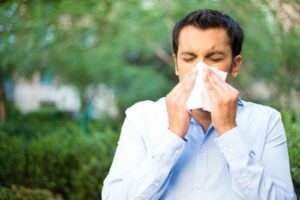Defeat allergens: here’s how to control the dust, mold, pollen and other contaminants that are making you sneeze.

1: Not Keeping a Barrier Between You and Your Bedding
Use zippered dust-proof casings for pillows and mattresses. The pore space of such casings is so small that dust mites and their waste products can’t get through.
2: Vacuuming Without a HEPA Filter
Use HEPA (high-efficiency particulate air) filters to prevent tiny particles of dust from being blown back out into the air.
3: Forgetting to Change the Vacuum Filter
Changing the filter is an essential part of keeping dust out of the air and preserving the life of the machine. Change the filter once it’s showing wear and tear or every six months if you’re using a HEPA filter.
4: Forgetting to Change the AC Filters
Never run your heating or air conditioning system without filters, and be sure to change them at least every three months.
5: Not Ventilating Your Bathroom
Running the exhaust fan (and making sure it’s vented to the outdoors) helps remove moisture from this naturally humid room.
6: Not Attending to Your Gutters
Leaky gutters can cause excessive moisture to enter your basement or crawl space. If you don’t have covered gutters, frequent litter removal is a must year round.
7: Too Many Textiles in the Bedroom
Carpeting, rugs, pillows, upholstered headboards and chairs are all dust catchers. Consider minimizing furnishings for an easier-to-dust environment.
8: Too Many Textiles in Your Living Area
The living room is the same as a bedroom. Keep upholstery to a minimum to reduce the amount of dust mites.
9: Inviting Allergens Into Your Yard
Avoid plants that are wind-pollinated — grasses are among the worst pollen offenders.
10: Not Following Your Nose
If you detect a musty smell in your home, inspect closely until you find the source of the smell. The sooner you find the mold, the easier it will be to remove.
11: Not Organizing Your Home Office
Clutter can harbor a plethora of dust mites — this includes stacks of papers, old magazines and office equipment. File paper inside a cabinet to stay organized and keep dust away.
12: Wearing Shoes Inside the House
Not only is wearing shoes indoors a health risk, but it can also increase allergens. Wet leaves bring in mildew and pollutants from grass get trapped on the bottom of shoes. Take your shoes off outside, or put them in a washable tray as soon as you walk in the door.
13: Letting the Trash Pile Up
You could attract some unwanted guests (like mice and roaches) inside your home if you let your trash pile up. Their droppings can worsen your allergies, so make sure you stick to a routine of taking out the trash.
14: Displaying Houseplants
You may enjoy your beloved fern, but houseplants encourage mold growth. Mold spores live in warm, wet dirt, so limit the amount and time you display them.
15: Letting Your Pet Sleep in Your Bed
Your favorite part of the day may be snuggling up to your fur baby, but pet dander traps allergens — which means you’re inviting those allergens to your bed. If you can’t resist the cuddles, then you should completely shave your dog. Just kidding — just be sure to bathe them once a week.
16: Keeping the Temp Too High
Dust mites and mold love to live in warm climates. Keep your thermostat around 70 degrees to help keep them at bay.
17: Installing Wallpaper in the Bathroom
Patterned wallpaper is a beautiful addition to any room, but installing it in wet rooms (bathrooms and kitchens) can increase the risk of mildew. Opt for tile or textured paint that’s mold-resistant.
18: Not Using the Exhaust Fan When Cooking
If you love cooking, all that steam from the stovetop will produce excess moisture. Turn the exhaust fan on to reduce it, helping to decrease the chance of mold.
19: Ignoring Your Bathmat
Think about it. You step onto your bathmat completely wet on the daily. To keep it fresh (and to keep mildew away), hang it to dry after every use, and stick it in the washer once a week.
20: Avoiding Protective Wear While Gardening
Even if you aren’t highly allergic to pollen, it can still irritate your eyes, nose and throat. To prevent this, always wear a mask and gloves while working in the yard.
Source: hgtv.com



